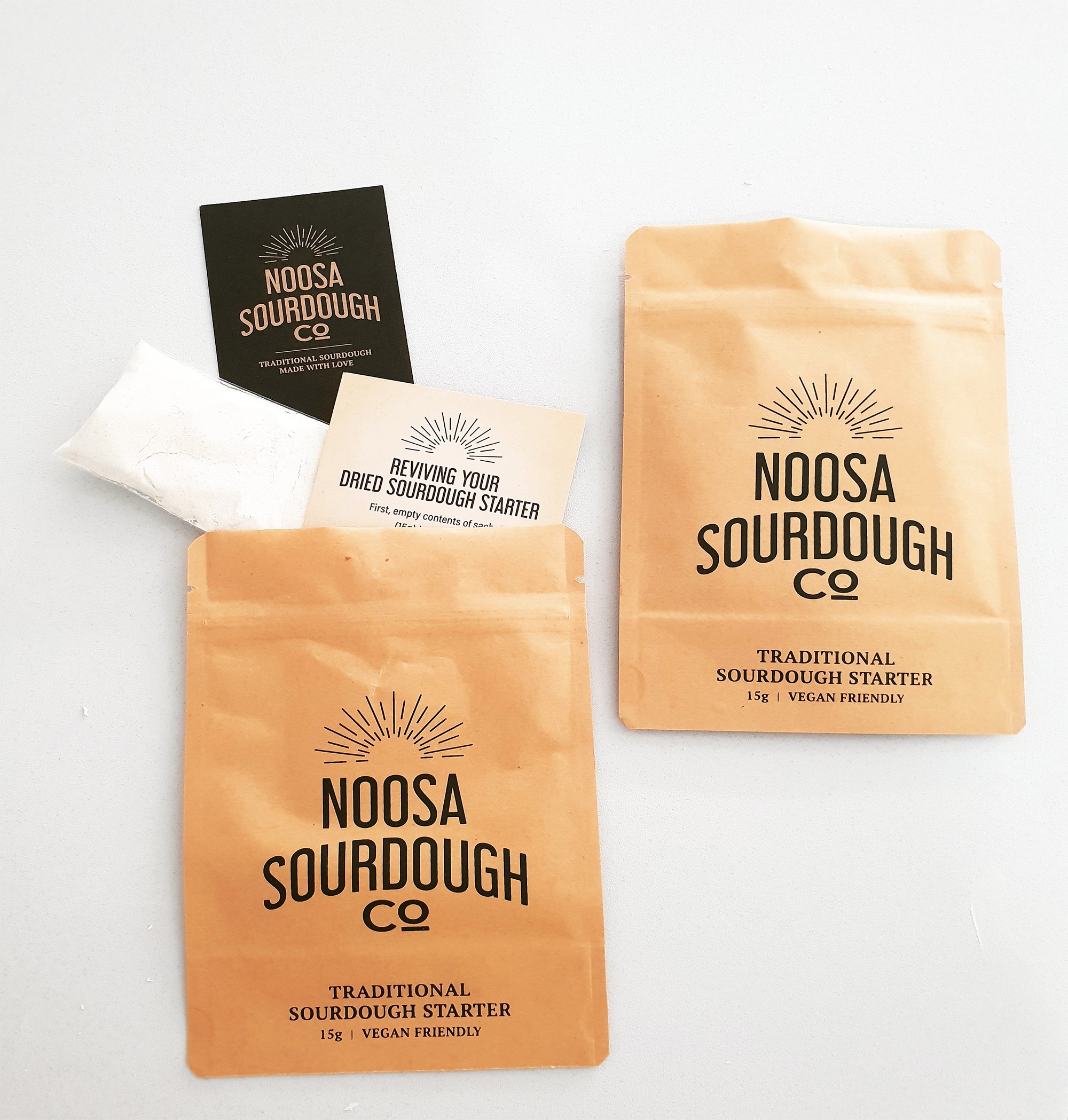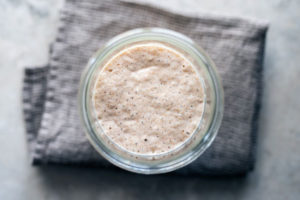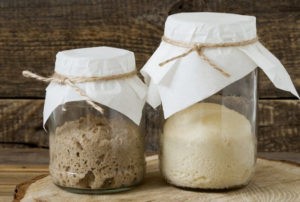Sourdough FAQ’s
I LOVE making Sourdough Bread for my friends and family and I LOVE teaching others the easy way to make it too.
There are literally hundreds of recipes out there for you to discover using Sourdough Starter – you will be amazed at what you can use it for.
There are many many different styles, techniques, terminologies and recipes out there too, and some are more confusing than your first science experiment at school. There is no right or wrong way to make Sourdough, it’s just best to find a routine and recipe that fit’s in with your life, and stick to it.
Sign up for my EASY RECIPE – www.noosasourdough.com.au/signup and I’m sure you will be well on your way to Loving your newfound craft of Sourdough Baking.

What is sourdough starter exactly?

Sourdough starter is natural or “wild yeast” and bacteria that’s grown over time with the help of water, flour and fermentation. If you’re relying on natural yeast for your starter, it can take some time for it to develop. If you don’t have time or just want a bit of guaranteed success, use the Noosa Sourdough Dehydrated Starter Kit
This mix of yeast, flour and water that’s been fermented gives sourdough bread its rise and flavour.
What should I mix the Starter Kit in and how do I store it?
Be sure to choose the right container for storing your starter. You’ll want the container to be about four times the size of the starter so it has room to grow. A large Mason jar is a great vessel for keeping your starter. Just be sure not to seal it (or any container you use) too tightly. You want to allow gasses to escape from the container so it doesn’t explode!
Once you have an established starter, you can keep it in the fridge.
I actually use a simple plastic container with a lid… if it gets really gassy, the lid just pops off. ( glass can explode!)
How long does it take for a sourdough starter to mature enough to begin baking?
Creating a sourdough starter from scratch can take anywhere from 7 days to 2 weeks depending on many factors.
These factors include the ambient yeast in the air, the temperature that the starter is kept at, the type of flour and water that is used, and the technique that is used.
I’ve REVIVED my Starter, but it’s not working?
It will take 24 to 48 hours to be REVIVED. You have to remember, this is not the same as “feeding” an existing Starter. You are just waking this up so it’s NOT going to double in size or do anything miraculous at this stage.
It will get tiny bubbles ( that look like black dots) on the surface ,and that’s about it.
It IS READY to use now, so mix up a batch and see how it goes.
Why isn’t my starter Rising after I feed it?
The rise of the starter has to do with the age of the starter, the yeast and bacteria in the starter, as well as the amount of fuel that is being fed to the starter.
More mature starters tend to react quickly (within 3 hours after being fed) because as they age the metabolic breakdown of new food after being fed is much more efficient.
If you have a relatively new starter, it may take a little while for it to become consistent after feeding. When I mentioned consistency after feeding what I mean is that you will have a predictable amount of rise within a predictable amount of time each time you feed your starter.
My starter’s rise slowly over a two to three hour window after being fed.
Other factors that can affect your starter are:
- Temperature– aim for around 22 – 26 degrees Celsius ( if you want to get technical)
- You will find it’s faster in summer and a bit slower as it cools down. I find adding a bit more starter in you mix will help when bulk proving too when its cold.
- The type of flour you use will affect the amount of rise, too. Whole grains have more enzyme activity, thus, more rise. Try adding 1/3 whole wheat to your starter when you feed to see how it changes the rise.
- After feeding your starter, it should get bubbly and increase in volume over the course of a few hours. This is evidence that the yeast is consuming nutrients and releasing gas. “Bubbles are the sign that the starter is alive and thriving!” Josh says.
- Just be aware that after eating, the starter will deflate again. This boom and bust is part of the cycle of sourdough starter.
What is the clear liquid that I see sometimes at the top of my starter?
That liquid is called Hooch. Hooch Is basically the alcohol that has formed from the metabolism of the yeast in your starter. If you see the liquid on top what that means is that your starter has eaten all of its food and has turned the byproducts into alcohol.
Most of the time you will stir the hooch back into the starter. it creates a more sour taste to your sourdough. If you don’t want a strong sour taste and you see the liquid on top gently tilt your jar and pour the hooch off.
If you see Hooch often on your starter, that means that your starter is not getting enough food. you’ll want to increase your feeding amounts each time you feed.
How can I get my sourdough to be more “sour”?
The sour flavour comes from a variety of things.
- How mature your starter is
- How long you let your dough rise — the longer the rise, the more flavour
- A refrigerated dough — cold fermentation — can create a more sour flavour because cold proofing creates more acetic acid. Stick your dough in the fridge or cold oven overnight to increase the flavour.
How should I store my sourdough bread?
Loosely covered for the first 2 days with a clean towel, or paper bag. Then for the next 3 to 7 in a sealed plastic bag.
NEVER refrigerate your bread — it sucks the life out of it.
You can freeze it for long term storage. Wrap tightly with plastic wrap then seal in a plastic bag. Will be good for up to 3 months this way. To bring back to life, just pop it in a 350°F oven for about 10 minutes.
I brought the Starter Kit but there aren’t any recipes inside?
On the REVIVAL INSTRUCTION CARD ENCLOSED, is a QR CODE to scan. There is also the link to go to. www.noosasourdough.com.au/signup Sign up and you will receive the recipe instantly, and while your Starter is reviving, the following day, you receive another email explaining CARE OF YOUR STARTER. You will also receive a few more emails containing more recipes (pizza, fruit loaf etc.) and other helpful tips and information.
My starter isn’t working?
Remember – you are only REVIVING the dehydrated starter in the first step… see expectations above.
My starter doesn’t float?
It doesn’t actually have to. Remember, this isn’t in the revival process…this is after you have fed your starter (equal parts flour and water). Sometimes it will and sometimes it won’t. As long as your Starter has been fed within 24 hours, you can still use some of it to successfully make a good batch (bread or pizza etc.)
How many loaves does one Starter Kit make?
Once you have a nice strong Starter, it will keep FOREVER with a little bit of love along the way. You will never use all of your starter, as you “feed” it along the way, with always a bit more than you actually require. You feed it, take some out and the remainder goes back in the fridge until your next baking day, you feed it, take some out and the leftover goes back in the fridge..repeat, repeat.
I fed my starter yesterday and baked, but want pizza for tonight – do I have to feed the starter again first?
As long as there is enough starter in your container for the required amount, leaving some to feed the next time, then go ahead. You will learn, Sourdough is actually very forgiving, and as long as its been fed recently, it will still work ( a bit like us really!!) Just don’t use all of it, otherwise you will have to start from scratch again!!
What do I have to feed my starter with?
You can use any flour you want – but each one will react differently. Wholewheat or Rye type flours will react faster ( make it grow faster) whereas something like unbleached white or Spelt may be a bit slower.
Do I have to use the same flour to feed the Starter every time?
No you don’t have to. You can use different flours if you want to… You may just notice it will become a bit dryer with wholewheat / rye flour, just add a bit more water until it resembles glue!!
How often should you feed sourdough starter?
When storing a starter at room temperature, I recommend daily feedings.
If you store it in the fridge, it’s a good idea to let it come to room temperature once a week and feed it then. Fridge storage is best if you want to keep your starter going long-term. Remember, it is a living thing, and while you want the natural bacteria for the fermentation process, you don’t want it to go mouldy!!
Do I need special water to feed my starter?
Regular tap water is just as good as any, however, if you live somewhere that has a high chlorine content, you can still use it, but maybe leave a filled container overnight on the bench so the chlorine can dissipate.
What if I’m not Home to Feed my Starter?
This is a very common question that beginners have. If you are used to feeding your sourdough starter every day and leaving it on your counter top, what happens if you want to go away on holiday? Or you simply don’t have the time to keep feeding it on a regular basis? The simplest solution is to place it in the fridge or the freezer if you are away for a few weeks.
Sourdough starter can be placed in the fridge to slow down its fermentation rate considerably. I always store mine in the fridge, and only take it out when I want to bake some bread.
I Forgot to Feed My Starter!
Absolutely no need to panic! If your starter is established i.e. older than a few months, it can take some neglect and still thrive. Forgetting to feed it occasionally will not weaken its strength. Simply wait until the next feed time, and continue feeding it as normal. It will be just fine.
I Don’t Have Enough Starter for My Recipe!
A sourdough starter can be fed a larger amount if necessary, and there is no need to ‘build up’ the amount of starter you have in order to have enough for a recipe. If you are going to be mixing your dough tomorrow, then feed your sourdough starter enough flour and water to fit your recipe amount. It will be ready to use the next day, and you will have exactly the amount you need!
I Can See Mould on My Starter. Can I Salvage it?
Mould on a sourdough starter is not a good sign. It means that there is not enough good bacteria surviving in the starter to be able to keep the bad bugs out.
If the mould is only on the surface, you can carefully remove it. Then take a tiny amount of visible clean starter and place it in a fresh jar. Continue to then feed it the way you normally do.
It’s important at this stage to keep a close eye on it and feed it regularly. Morning and evening, or once a day is a good routine. If you find mould is still developing, it’s time to say goodbye and start with a fresh one.
If the mould has gone into the body of the starter, again, it’s best to throw it out and start over.
My Starter Smells really weird – has it gone “off”?
Sourdough Starters are strange little creatures. They are as unique as you or me. And so is their aroma! Sourdough starters can have a range of different aromas and have been given a whole host of different descriptions, including:
- old socks
- nail polish
- bread
- vinegar
- fruit
- paint
- alcohol
In the end, the way your starter smells is NOT a reflection of how ‘good’ the starter is. It’s a reflection of the types of wild yeast and bacteria that live in your starter. And this is unique to every starter.
NOTE: You may find that the starter smells more on the nail polish/alcoholic side if it’s developing hooch on the top. But that should be remedied by sufficient feedings. It’s not a sign that your starter has gone bad.


Get in Touch
© Noosa Sourdough Co. 2021 All Rights Reserved Website by Digital Spaces
